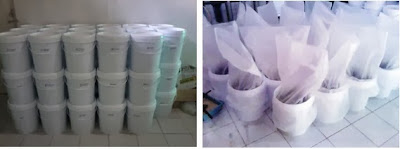Coconut sugar, which has low glycemic index, is one of the best natural sweetener.
This flow process includes organic certification process and its requirements, raw material collecting and handling as well as production process in the plant.
Hopefully, this flow process can give general depiction about how our company process coconut sugar to make coconut nectar (coconut syrup), coconut blocked sugar or coconut crystal sugar.
1.
CERTIFICATION PROCESS
Certificate
by : Control
Union Certification – Holland.
·
Raw material
(sap/neera) certification
·
Process certification
Raw
Material Certification
More
than 1000 coconut trees are proposed to be certified by Control Union
Certification. This certification body will then checked the compliance with
the requirements of organic standard.
(detailed requirements for organic certification can be seen in the last part of this articles)
2. RAW
MATERIAL DELIVERY
Sap
collecting process (in coconut plantation). The amount of sap from each farmer
(who has been listed by Control Union Certification) is recorded as well as
total dissolved solid, pH, etc.
Sap
transporting from coconut plantation to processing plant.
Sap
transferring to receiving tank in processing unit
Washing
the transporting tank at the end of every delivery process
3.
PRODUCTION PROCESS.
 Sap Receiving and Purifying
Sap Receiving and PurifyingFrom receiving tank, coconut sap is pumped to the sap heater. Sap is heated until 105 Celsius to inactivate microbe, yeast and others.
Hot sap is then settled in the settling tank for 3 – 5 hours. The impurities (which are approximately 5%) will be present in the bottom and treated as waste. Only the clear liquid on the top will be further processed.
The
above photos depict the appearance of sap before and after purification
process. The clear sap is then passed through 5 micron filter.
Coconut Sap Characteristic
Density
on 20 Celsius 1.058-1.077.
Total
Solids 15.2 - 19.7 gr/100 ml.
Sucrose 12.3 - 17.4 gr/100 ml.
Ash 0.11 - 0.41 gr/100 ml.
Protein 0.23 - 0.32 gr/100 ml.
pH 6.2 - 7.2
(fresh).
B. Clear Sap Evaporation
The evaporation process is performed in a triple
effect vacuum evaporator. Temperature of the third evaporator is maintained to
be around 65 Celsius on vacuum condition of 64 cmHg. The result of this process is increasing the
brix of sap from 14 to light syrup (50-55)
Light syrup resulted from the evaporator is then
thickened to make end product; coconut nectar (coconut syrup) or coconut
sugar.
Coconut Organic Nectar
(Coconut Organic Syrup)
The purpose of syrup thickening is to make syrup
which has 75 brix level. This process is carried out by single effect vacuum
pan. Temperature is maintained to be around 55-60 Celsius with vacuum condition
of 65-70 cmHg. The controlled increasing of color intensity produces light
yellow end product (instead of dark brown syrup)
Coconut Organic Sugar (or Block Sugar as customer request)
Differ
with traditional coconut sugar (commonly known as ant sugar), our centrifugal
crystal sugar has SWEET ONLY taste without any caramel taste or coconut
specific smell.
D. Product Packaging
As requested, syrup packaging can be water gallon
or pails with HOT FILLING process to avoid fermentation.
Water
Galon 25 kg
Pail
25 kg.
Additional Notes:
· All packaging material (water gallons or pails) are
sterilized using alcohol before filling.
- No hand touches during production process.
Requirements
for Organic Coconut Plantation
Certification
Below are some general requirements which have to
be fulfilled by coconut plantation to get Organic Certifications (from planting
to harvesting):
·
Coconut plantation is said to be ORGANIC when growing
naturally without chemical fertilizer or chemical pesticides. Farmers will use
natural fertilizer from barnyard manure or green manure obtained from composting
leaves.
·
Any plants between coconut plantations must also be
organic, that grow naturally without any chemicals. For example: coffee, which
is planted with natural seeds and not fertilized with inorganic fertilizer.
·
Coconut trees and all plants in between have used organic
natural plantation method for at least 4 years. During the last 4 years,
farmers no longer used either chemical fertilizers such as phosphor, kalium,
etc or chemical pesticides such as Furadan, Curraterr, Indofur, Dharmafur, etc.
·
Other plantation area within radius of 25 meters from
outer border of organic plantation must also use organic growing methods.
·
Tapping
(harvesting) the sap :
·
Sap tapping equipments, such as sickle, sap container
must be routine and frequently cleaned using water and napkin that are free
from inorganic materials (detergent or soap).
·
Sickles used to harvest the sap may not used for other
purposes, such as harvesting grains or canes.
·
Sap containers must be made from organic materials
(bamboo is the best) and may not made from ex lubricating oil bottles or ex chemicals
containers.
·
When sap is transferred to a bigger container, such as 30
liters plastic containers, then the containers must also be routine and
frequently cleaned by using water without any inorganic materials (soap or
detergent)
·
No chemicals addition in harvested sap, such as meta
bisulphide.
Adding lime solution with appropriate dosage.
This lime solution is made by diluting 600 cc lime into 50 liters water. Only
the top part of the solution is used for this purpose. This lime solution is
supplied by PT. Agri Utama for the same farmers group.














